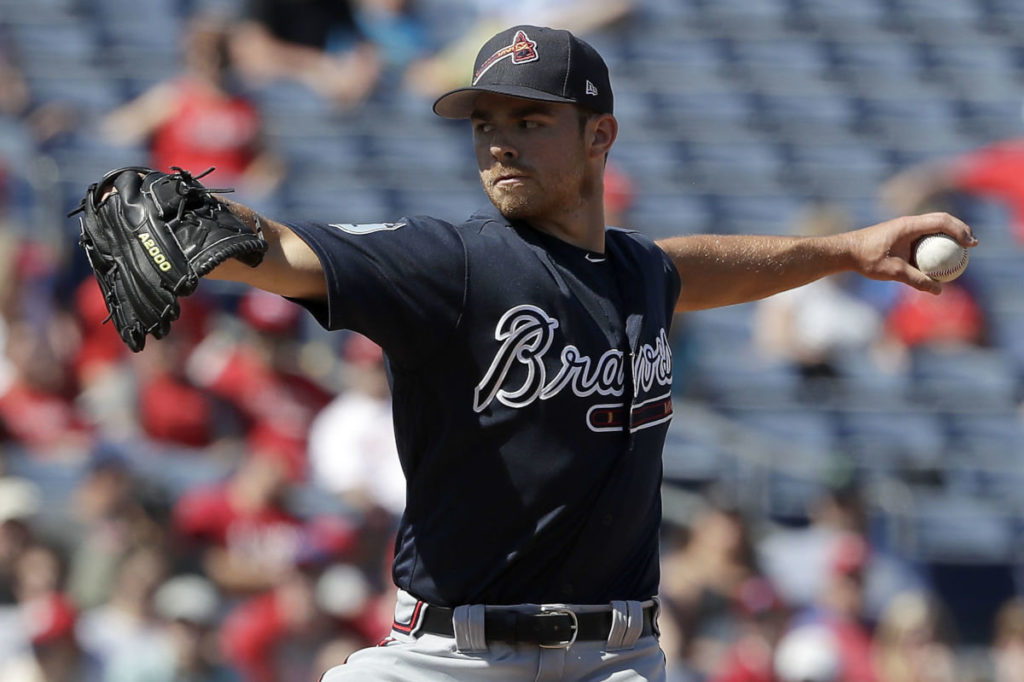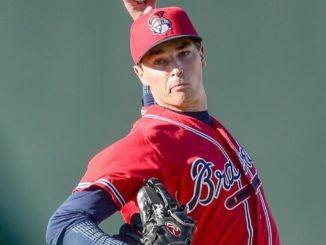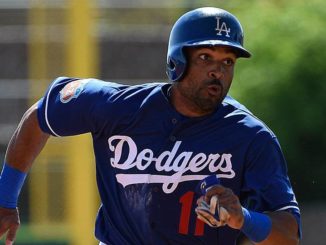Atlanta announced a trade on Monday afternoon, sending RHP Arodys Vizcaino and LHP Jesse Biddle to Seattle for 33 year old RHP Anthony Swarzak and cash considerations. The cash is simply there to balance the financial aspects of the trade, meaning Atlanta nor Seattle will spend any extra money as a consequence of this deal.
Let’s get what is lost out of the way first. Arodys Vizcaino ends his second Atlanta tenure the way he spent much of it, with an IL stint sidelining him. When on the mound, Vizzy was generally helpful in his six seasons. He posted a 2.77 ERA and 50 saves, with 197 Ks in 172 innings, spending plenty of time as the closer without ever really permanently grabbing the role. That was due to the injuries, of course. In six seasons, he had as many trips to the DL/IL with a variety of maladies – strained obliques, shoulder inflammation, a strained index finger, more shoulder inflammation, even more shoulder inflammation, and finally, yes, more shoulder inflammation. The shoulder ultimately did him in, ending his 2019 season, which is frustrating timing for a good reliever on the cusp of free agency. With that free agency coming this offseason, Vizcaino offered nothing immediate for Atlanta or Seattle, which means his inclusion in this trade is largely about offsetting the financial difference between the other players involved. Seattle now gets to oversee his rehab, and the Mariners will have the best and closest idea of exactly where Vizcaino is when the offseason arrives. If he winds up being a healthy, under-the-radar option this winter, Seattle may be in the best position to sign one of the winter’s better bargains. Similarly, if the shoulder woes finally conquered him, the Mariners will know to avoid him. But make no mistake, Vizcaino is mostly here because Anthony Swarzak is on the expensive side.

Jesse Biddle’s rise from failed starting prospect to 2018 bullpen star has been well documented, and 2019 saw his star fade as quickly as it first illuminated. The things that went so right for Biddle last year have been his undoing in 2019. He went from finding the zone 51.2% of the time (better than MLB average) to 45.2% (worse). Batters swing at fewer balls, make more contact when they do, and have increased their line drive and fly ball rates. Biddle’s pure stuff is still there, as the velocity and movement on his pitches resemble their 2018 iterations. But the command and control of them is not. This is particularly true of his fastball. Batters batted .277 against the pitch in 2018, and they’re hitting .423 off it in 2019. Biddle, who has walked 10 batters in his 11.7 innings of work, is broken. Broken pitchers can be fixed again, but playoff contenders aren’t the best place for struggling pitchers to work through their issues. Biddle probably belongs in a MLB bullpen. 11.7 innings aren’t quite enough to completely write off everything he did well just a season ago. At the same time, the Braves are one of the most volatile playoff contenders in the majors. According to Fangraphs, the Braves have a 52.6% chance of making the playoffs. A team with 100% odds or 0% odds could easily justify letting him work things out on the mound. Atlanta is on the knife’s edge, though. When you’re a team with 50% odds of making the playoffs, every win or loss matters more. At 80%, you have a buffer. At 20%, well, you probably weren’t going to pull it off anyway. But the Braves have a very real chance to make the 2019 postseason, and they can’t justify the time it may require for Jesse Biddle to work through his issues. Perhaps the Mariners (1.2% playoff odds) will do just that. And if he manages to rediscover the strike zone, Seattle can enjoy the fruits of their patience. Biddle would be under team control for another 4 seasons.
Granted, this isn’t exclusively an analysis of the trade as much as it is Atlanta’s ultimate decision to part ways with Biddle, which really came last week when the team designated Biddle for assignment. Left with the options of putting him on waivers, trading him, or granting his release, Atlanta found the option that worked best for them. Biddle had value to a non-contender, and the Mariners managed to turn a reliever they only controlled for what appears to be a lost season into one they could control when they’re good again. Let’s get to that reliever.
Drafted in the 2nd round of the 2004 draft by Minnesota, Anthony Swarzak debuted as a starter in 2009 for the Twins. His role as starter went pretty badly, and in 2013 Minnesota used him exclusively as a reliever, with good results. He’s been a journeyman over the last half decade – that ’13 season, he has pitched for the Twins, Indians, Yankees, White Sox, Brewers, Mets, Mariners, and now, Braves. Swarzak had his best season in 2017, posting a 2.33 ERA and 2.92 DRA across 77.1 innings with both Chicago and Milwaukee. The Mets handed Swarzak a 2 year, $14M deal that offseason, and they didn’t get much for their investment in 2018 – Swarzak failed to miss bats with the same regularity, batters hit the ball in the air, and with a .344 BABIP, they battered him to a disappointing 6.15 ERA. Traded to Seattle as part of the Robinson Cano deal, his Seattle results have been similarly disappointing – posting a 5.27 ERA in 13.7 innings. With the Mariners flailing in the standings and Swarzak not signed beyond 2019, he became expendable.
What kind of reliever is Atlanta getting? Swarzak has a simple two pitch repertoire. He throws a 93-95 mph four seam fastball and an 85-87 mph slider. Here’s the fastball:
And the slider:
He’ll use both pitches pretty equally against lefties, while he prefers hammering right-handed batters with sliders early and often in the count. It’s a good pitch against same-side hitters, generating ground balls and keeping batting averages low. This is a pitch that needs a good defense behind it. According to a few advanced metrics like UZR and DRS, Seattle has MLB’s worst defense in 2019. Atlanta’s is closer to average, but that’s a big change if you’re a ground ball reliever.
He’s not coming over without problems of his own. The fastball has given him a few problems this year – of the six homers he’s allowed this season, five were off his fastball. There’s nothing a defense can do if the ball flies out of the park. Atlanta’s immediate goal should be to see if they can fix his fastball command or dial back his usage of the pitch a bit. Either way, that has been one of Swarzak’s two bugaboos in 2019. The other, and get ready for this, Braves fans, has been walks. With 8 in his 13.2 innings, and a strike % below league average for the second straight year, Swarzak isn’t challenging hitters as much as he should. It isn’t frustrating on the same level as Biddle, but if you’re looking for Swarzak to fix the strike zone issues endemic to this bullpen, you’re gonna have a bad time.
Swarzak isn’t likely to drastically move the needle on the 2019 season. He isn’t a reliever likely to become elite in the 8th and 9th innings, and he won’t silence the cries for Kimbrel, but he’s someone the team should be able to be at least somewhat comfortable with taking the mound in middle innings this season. At a relative cost of nothing but the future of Jesse Biddle, that’s exactly the kind of flier the team should be taking at this point. There’s a realistic future where Swarzak is a reliable middle inning guy. There’s an equally realistic future where Swarzak is designated for assignment. When there’s a minimal cost, there’s minimal risk, but the reward is typically limited as well. The ceiling on Swarzak hangs awfully low, but that doesn’t mean reaching it wouldn’t help Atlanta. This is likely to wind up being either a good trade or an insignificant one for Atlanta, and considering the price paid, that’s a good deal.




Leave a Reply